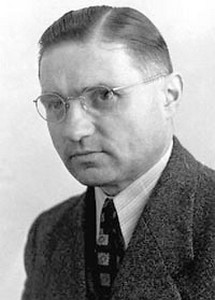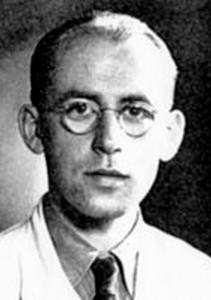Gassner, Alfred
( * - )
1935 - 1937 JFM Construction Office
Alfred Gassner was Born in Austria, but moved to the U.S. later on. During the 20s and 30s he worked for Fairchild Corporation before he returned to Europe in 1935. He Joint the JFM on personal request of Heinrich Koppenberg and assisted Zindel in Detail design questions of the Junkers Ju88. In 1937 Gassner left Junkers and moved to Sweden. Gassner was employed by AB Forenade Flygverkstäder (AFF), which was founded in 1937 to design aircraft for ASJA at Linköping and the new Company Svenska Aeroplan AB (SAAB) at Trollhättan. He designed the F-1, an oberserver aircraft similar to the Westland Lysander. This aircraft was offered to the Swedish Air Force on 15 Aug. 1938 togehter with the ASJA L-10, which had been designed by a Team of American Designers. The L-10 was prefered and was later built as the SAAB 17. Grassner's F-1 was discontinued. When ASJA was incorporated into SAAB in March 1939, Gassner left the Company and returned to the U.S. after a short stay with Fokker in the Netherlands.
Dr. Gasterstaedt, Johannes
( * 1888 - 25 Feb 1937 )

1923 - ???? Junkers Main Office
???? - 1938 Junkers Motorenwerke
Johannes Gasterstaedt joint the Junkers Hauptburo in 1923. Later he moved to the engine division and was responsible for the developement of the Junkers Oil Engines. Gasterstaedt finished the Jumo 204 Engine Development in 1932 and further developed the Jumo 205. Later Gasterstaedt started the development of the Jumo 223. But just a year after the Project start, Gasterstaedt died in 1937. Manfred Gerlach continued Gasterstaedt's work after his death.
Weblinks:
- Google Patents - Hydraulic Clutch Patent von Gasterstaedt
Gausmann, Carl
( * 27 Mar 1895 - ???? )
Carl Gausmann joint the Junkers Research Institute in September 1923. Later he moved to Prof. Mader as a design engineer and worked on the Junkers Fo2, Fo3, Fo4 Oil Engines as well as on the L5, L8 engines and the Jumo 210. From 1938 he was the manager of the Jumo construction office of the serial production. After WWII he was responsible for managing the remaining Junkers patents.
Gerlach, Manfred
( * 5 Jul 1905 - 1974 )

1924 - 1926 Fili Plant Russia
1926 - 1945 JFM Design Office
later Jumo
Manfred Gerlach started his carreer at Junkers at the Fili Plant in Russia. In 1926 he returned to Dessau and became a test engineer in the Oil Engine Department. Later he became Test Cell Manager at JFM. After the death of Johannes Gasterstaedt, Manfred Gerlach took over the development of the Jumo 223. He was also engaged in the development of the high altitude engine of the Junkers Ju86. . At the end of WWII Gerlach was responsible for the Jumo 224 developement, which was continued in Kuibyschew after WWII.
He returned to East Germany in 1954 and became Technical Director at the Pirna Motorenwerke, where he developed several engines for the VEB Flugzeugbau Dresden. Following a Crash of the Pirna 018 in 1959, Gerlach was arrested by the Stasi. He was released in 1969 and sent to West Germany.
Gimm, Alfred
( * 5 Jul 1899 - )

1925 - 1945 JFM Engine Plant
1946 - 1954 OKB-II Kuibschew
1954 - 1961 Pirna Engine Plant (since 1955 Test Cell Manager)
Alfred Gimm Joint the Junkers Engine Plant in 1925 as a test engineer. He supported Gasterstaedt in the development of the Jumo 204. In 1929 he became Manager of the pre series test cell in Dessau Later Gimm participated in the Jumo 222 development.
In 1946 Gimm was sent to Kuibschwe, where he worked on the Jumo 012B PTL and the NK-12. In 1954 he returned to Germany and worked on the Setup of the Pirna Production Facility. In 1955 he became test cell Manager at Pirna.
Griebisch, Franz
( * 1894 - )

1923 - 1945 JFM Construction Office, Electronical Components
1946 - 1954 OKB-I Podberesje
Franz Griebisch Joint Junkers in 1923. He was responsible for the elctric Equipments of aircraft. In 1933 he became head of the experimental lightweight laboratories.
He Joint Hugo Junkers at Bayrischzell in 1934/35 and worked on Junkers' steel Building constructions. In 1935 he returned to Dessau and became a specialist in Aviation lightweight constructions.
In 1946 Griebisch was sent to OKB-I in Podberesje, where he stayed until 1954. Griebisch became Project planning engineer for the Setup of the new VEB Flugzeugbau Dresden Facility. He later became director at the Aeronautical Research Center in Dresden.
Weblinks:
- Flugzeug Lorenz - German Griebisch Biography
Gropler, Hans
( * 29 Jun 1909 - )

1938 - 1945 JFM Project Office
Hans Gopler Joint Junkers following his Engineering studies in Berlin. In 1939 he succeeded Quick as the Head of the Design Office. In 1944 Gopler left Junkers and became Professor at the Technical Highschool of Danzig.
After WWII Gopler Joint Prof. Hertel in France. Since 1952 Gopler worked with MAN in Nurnberg.
Weblinks:
- Flugzeug Lorenz - German Gopler Biography
Gsell, Robert
( * 1899 - ???? )
1912 TH Aachen
Robert Gsell was one of Germany's early pilots. In 1912 he first flew the Reissner Cunard of Prof. Reissner and Prof. Junkers in Aachen. He joint Flugzeugbau Friedrichshafen in 1912 and performed several record flights for them. During WWI he joint the DVL and in 1919 he participated in the F13 altitude record flight of "Annelise".
Guenther, Waldemar
1945 - 1946 JFM Static Calculation Office (Head)
Waldemar Guenther was member of the Static Calculations Office at Junkers during WWII. When Karl Aikele left his Position as the Managing director, Guenther took over the Departement. He was later moved to Russia.
Dr. Haber, Fritz
???? - 1945 Junkers Design Office
Fritz Haber was member of the Design Office at Junkers Flugzeugwerke during WWII. During the late phases of WWII he was responsible for the Mistel designs with Ju88 and Ju287 bombs. For that purpose Haber designed an electrical control system to transfer stick motions from the carrier aircraft to the bomb fuselage. Thus Haber claimed the first aircraft fly-by-wire system.
Hackmack, Hans
1922 - 1924 JFM Experimental Flight Unit
1924 - 1927 Junkes Fili Director
During WWI Hackmack joint the Fliegertruppe. In 1919 he started engineering studies at Darmstadt University. In December 1922 Hackmack joint Junkers Flugzeugwerke as a pilot and experimental engineer. In 1923 he became the managing director of the Experimental Flight Unit. In 1924 Hackmack went to Fili and became technical director of the Russian Junkers plant. In 1927 he left Junkers and worked as a technical consultant for Luft Hansa. Hackmack was killed, when he crashed with a Messerschmitt M20 in 1928.
Hall, Paul
Paul Hall joined IFM in 1940, when he left Fiesler Flugzeugbau. Hall was specially engaged for the development of the sailing transporter Junkers Ju322, which should be used for the operation Seewolf, the planned occupation of England.
Handke, Erwin
( * 12 May 1911 - )

1934 - 1945 JFM Design and later Development Office
1946 - 1954 OKB-I Podberesje
1955 - 1961 Pirna Engine Plant Manager Karl-Marx-Stadt
Erwin Handke Joint the Design Office of Junkers in 1934. He later changed to the Development Office and worked on the Ju90. In 1940 Handke moved to Carl Zeiss, but returned to Junkers in 1945.
In 1946 he was sent to OKB-I in Podberesje. He became technical director of the Pirna Engine Plant at Karl-Marx-Stadt in 1955. Since 1961 Handke was director of the Orsta Hydraulics.
Weblinks:
- Flugzeug Lorenz - German Handke Biography
Haertl, Viktor
???? - ???? JFM Sales Department and JFM Main Office, i.e. Mitsubishi License Program
???? - 1945 Letov Facility Manager
Hartmann, Gerhard
( * 26 Jan 1908 - )

1934 - 1945 JFM Construction Office, Tail Units
1946 - 1954 OKB-I Podberesje
1955 - 1961 VEB Flugzeugbau Dresden
Gerhard Hartmann Joint Junkers in 1934. Together with Fritz Freundel he was engaged in the development of tail Units in the construction Office. He was responsible for the Ju88 tail unit construction and later became head of the tail unit construction Office.
In 1946 he moved to OKB-I in Podberesje, where he continued the tail unit design of the Ju287, EF131 and EF152. Since 1955 Hartmann was responsible for the tail unit Trials of the Baade 152 at VEB Flugzeugbau in Dresden. He was also engaged in the development of the Baade Turbine Car.
Weblinks:
- Flugzeug Lorenz - German Hartmann Biography
Haseloff, Johann

1921 JFM Design Office (Fuselage)
1946 - 1954 OKB-I Podberesje
1955 - ???? VEB Flugzeugbau Dresden
Haseloff was member of the construction office of Dr. Zindel at Junkers Flugzeugbau since the early 20s. He was responsible for the fuselage design of the Junkers J21 built for Russia and for the Junkers G24. Since 1923 Haseloff was the head of the fuselage construction Office. He developed a new fuselage design with the Ju160 fuselage.
After WWII Haseloff was sent to Podbersje with the Baade Team, where he continued his fuselage design work of the Ju287. Since 1955 Haseloff was a construction Manager and Deputy Chief construction engineer at the VEB Flugzeugbau in Dresden.
Hempel, Werner
( * 6 Dec 1910 - )

1936 - 1945 JFM Construction Office
1946 - 1954 OKB-I Podberesje
1955 - ???? VEB Flugzeugbau Dresden
Werner Hempel Joint Junkers Construction Office in 1936. Since 1938 Hempel was engaged as an experimental engineer and later worked at the HK900 Wind Channel.
In 1946 he was sent to OKB-I at Podberesje. After his return in 1954 he Joint the VEB Flugzeugbau Dresden, where he became responsible for the construction documentation.
Weblinks:
- Flugzeug Lorenz - German Hempel Biography
Prof. Hertel, Heinrich
( * 16. Nov. 1902 + 5 Dec1982 )

1939 - 1945 JFM Directors Board
Prof. Heinrich Hertel started his carreer as a student of construction engineering at the TH Munich. In 1926 he joint DVL in Adlershof and in 1932 he swapped to Heinkel Flugzeugwerke. In 1934 Hertel was appointed the technical director of the Heinkelwerke, where he was responsible for the Heinkel H100 and He111 developement.
He joint IFM in May 1939 as a successor of Prof. Herbert Wagner. He started his Junkers activities with the developement of the Junkers Ju288 He was also a member of the IFM board of directors since 1939 and the deputy chairman of this board.
After WWII Hertel first went to France and worked with several offical organisations and companies there. In 1950 he joint the TH Berlin and became aeronautical professor there. Since 1959 he was also a consultant for Focke Wulf in Bremen. In 1977 he finally retired.
Herzog, Otto
???? - 1946 JFM
1946 - 1953 OKB-1 Podberesje
Otto Herzog participated in the final construction of two Junkers Ju287 following the end of WWII in Dessau. In 1946 he was sent to Podberesje in Russia together with the Baade team. He returned to Germany in 1953 and organised the setup of the GDR aviation industry in Pirna. In 1957 he left the GDR and moved to Telefunken in Constance.
Hesselbach, Peter

Peter Hesselbach was a test pilot at JFM Dessau during the thirties and fourties. He first flew the Junkers Ju89 on 11th April 1937 and the Junkers Ju90 on 28th August 1937. At Bernburg he also few first the Junkers Ju322 transport glider in April 1941.
Dr. Hoerner, Sighard
???? - 1941 JFM Aerodynamic Design Office (Head)
Sighard Hoerner was the head of the Aerodynamic Design Office of Junkers during the second half of the 1930s. In 1941 Hoerner left Junkers and moved to Messerschmitt. He was succeeded by Georg Backhaus.
Hoppe, Fritz
1924 - 1934 Junkers Research Laboratories, later Experimental Flight Unit
Hoppe studied at TH Darmstadt and joint Junkers in October 1924. He was member of the Research Institute and later became manager of the experimental flight group. Ing. Hoppe was engaged in several first flights of Junkers aircraft designs. Together with Neuenhofen he flew first the A48 and he also flew first the Ju 49. In 1934 Hoppe left Junkers and took over responsibilities at DVL at Adlershof.
Huetter, Eugen
1934 - ???? Junkers Construction Office
Eugen Huetter was member of the construction office of Junkers Flugzeugwerke and worked under Pohlmann. He was responsible for the panel designs of the Junkers Ju87 dive bomber
Hundt, Wilhelm
( * 13 Apr 1906 - )

1934 - 1941 JFM Construction Office Tail Units
1942 - 1945 JFM Prague Construction Office (Head)
1946 - 1952 OKB-I Podberesje
Wilhelm Hundt studied Engineering at the Hannover Highschool. In 1934 he started his carreer at Fieseler as a detail construction engineer. In the same year he changed to Junkers Construction Office, where he designed tail Units for the Ju89, Ju90. He was also engaged in the development of the high altitude aircraft Ju86P and the prototype construction of the Ju288.
In 1941 he went to Opel at Russelsheim, where Junkers had a remote design Office. Since 1942 Hundt was the head of the Junkers Prague Construction Office, which was busy on the Ju290, Ju252, Ju388 and Ju287.
In 1946 Hundt was sent to OKB-I at Podberesje, where he was busy as an experimental engineer. He returned already in 1952 to Germany.
Weblinks:
- Flugzeug Lorenz - German Hundt Biography
Huss, Gustav
( * 25. June 1895 + 12. Nov. 1970 )
1920 - 1924 Junkers Construction Office
1924 - 1926 Fili
1928 - 1945 Junkers Qualification Unit
Gustav Huss studied engineering from 1918 to 1920 and joint Junkers Flugzeugwerke as an engineer in 1920. From 1924 to 1926 he worked at Fili and in 1928 he became responsible manager for the technical training at Junkers Flugzeugwerke. He remained in that position until 1945.
introduced Mar 2004, transfered 14 Feb 2018
http://hugojunkers.bplaced.net/
contents last updated 14 Feb 2018

